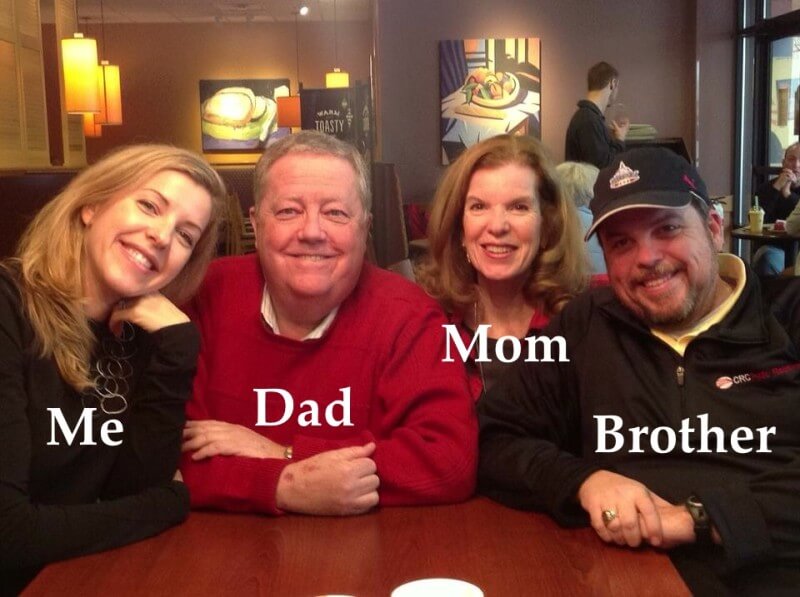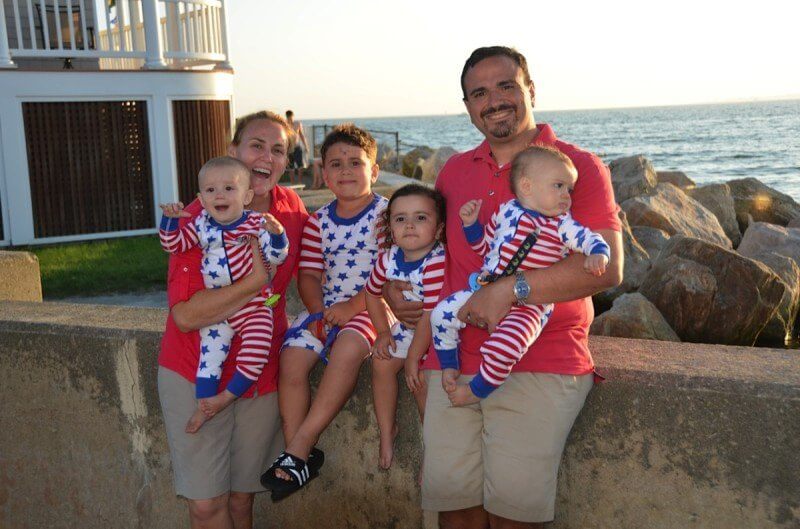Two days after my 17th birthday, my mom, who was 41 at the time, had cardiac arrest and should have died. But an hour prior, a voice as loud as anything I’ve ever heard told me to get my mom and go to my best friend’s house. Both of her parents were doctors and both had decided to come home a little early that day. I was worried about my mom because her heart was racing after a particularly nasty phone call where a business associate of my father’s decided to take out his anger on her. My dad was out of the country at the time and my brother was at Emory University. Other family members who were usually close at hand were scattered around the country that day. My mom and I were alone, but I listened to my inner voice and acted on faith, and she didn’t fight my demands (divine intervention in and of itself!) and, thus, had cardiac arrest at the feet of two doctors who happened to have taken the afternoon off.
When the ambulance arrived, they shocked my mom four times and pronounced her dead. There was nothing they could do. But, since two doctors were right there demanding they continue to shock her, the EMS continued and on the seventh shock, a weak heartbeat was detected. She lived. She was lucky: two physicians had administered CPR to her while waiting for an ambulance. Those same doctors demanded more shocks. She was dead for 37 minutes and yet she is alive today — a grandmother of 5, age 65.

There is so much more to this story — a sermon’s worth, a novel’s worth, a life full of “what if’s.” But that is not what today is about. Today is about heart health and how my mom’s story is one that repeats itself with women and men throughout our world. Some of it is hereditary (my mom’s dad also died of cardiac arrest at the age of 40) and some is lifestyle, but heart disease is our number one killer.
Now, before I continue, let me distinguish between a heart attack and cardiac arrest, as both are terms you need to understand: cardiac arrest is when the heart malfunctions and suddenly or unexpectedly stops beating. It is an electrical problem. A heart attack, on the other hand, is a circulation problem that is the result of blood flow to the heart being blocked.
Here are some sobering statistics*:
- Out-of-hospital cardiac arrest happens to nearly 383,000 people every year, and only 10.4% survive. Those who don’t survive most likely didn’t receive timely CPR.
- Of all cardiac arrests, 88% occur at home, with many victims appearing healthy and having no known heart disease or other risk factors. When CPR and AED (automated external defibrillator — the portable machine shocks the heart, which any business/residence can have on hand) are administered immediately, the chances of surviving cardiac arrest can double or even triple.
- A victim’s chance of surviving drops by 7 to 10 percent for every minute a normal heartbeat isn’t restored. Cardiac arrest is reversible in most victims if it’s treated within a few minutes.
Fortunately, survival rates are beginning to improve. Portable defibrillators are becoming more widely available and legislation in a dozen states (including Alabama, Georgia, Tennessee, North Carolina and more) requires hands-on CPR training for high school graduation.
Last spring this issue hit home once again when I met Lauren Donnelly, a delightful 37-year old woman and mother to four young children (twin infants and two toddlers). In a conversation over dinner, I found out that a mere three months prior, she had had cardiac arrest while having an early dinner at The Yellow Porch. Luckily, her husband, Dr. Gregory Bashian, a cardiologist at HCA, was with her. To this day, there is nothing that can be found “wrong” with her heart and doctors cannot recreate what happened: a random heart rhythm. She was a college athlete, works out, eats well. After talking with Lauren, I knew I needed to write about heart health for women now, during National Heart Health Awareness Month. We need more survivors. We need to do better than a 10.4% survival rate. We need more Laurens.

We asked Saint Thomas Health for the top ways that cardiac arrest and heart attack patients present, and we narrowed it down to women. Why just women? Most of the well-known signs are actually signs in men, not women. It’s Go Red for Women Month, so we’re doing our part. After all, I do have a lot to be thankful for. I have my mom.
Women, these symptoms or signs could mean you are experiencing a heart attack. Seek medical attention if you notice the following:
- Uncomfortable pressure, squeezing, fullness or pain in the center of your chest that lasts more than a few minutes, or goes away and comes back.
- Pain or discomfort in one or both arms, the back, neck, jaw or stomach.
- Shortness of breath, with or without chest discomfort.
- Other signs such as breaking out in a cold sweat, nausea or lightheadedness.
- As with men, the most common heart attack symptom in women is chest pain or discomfort. But it’s important to note that women are more likely to experience the other common symptoms, particularly shortness of breath, nausea/vomiting and back or jaw pain.
Here’s what you should know about cardiac arrest:
- Cardiac arrest usually strikes suddenly and without warning.
- It involves a sudden loss of responsiveness and no normal breathing. (If you witness this happening to someone, call for help immediately. Remember, the sooner CPR is started, and the sooner an AED is used, the better the chance for survival.)
- A recent study of men shows evidence that in some cases, cardiac arrest is preceded by warning signs for up to a month beforehand, such as chest pain, shortness of breath and dizziness, fainting or palpitations. Researchers are conducting similar work in women. (As an aside, my mom experienced these symptoms, which is, I’m sure, why I was on such high alert. Family members and friends, you need to be aware of these symptoms, as well.)
- If you have any of these signs, don’t ignore them – go to a doctor and have them checked out.
Now for some good news! Over the past 10 years, the death rate from heart disease has fallen about 39 percent. Rates among men have declined steadily over the last 25 years and rates among women have fallen, though at a slower rate. This is encouraging, however, heart disease remains our number one killer. So, what can you do to help your heart today? Here are the top four things:
- Stop smoking.
- Get 30 minutes a day of moderate to vigorous physical activity (walking is great).
- Eat a healthy diet rich in fresh fruits and vegetables, lean protein, whole grains, nuts, seeds, legumes, and low in saturated fat, sodium and added sugar.
- Control your numbers (blood pressure, cholesterol, glucose and body mass index)
Other things to consider after talking with Lauren Donnally:
- Host a CPR party. Seriously. Host a large group, spend a few hours getting CPR certified and then everyone throw in money for some chicken on the grill and a glass of red wine. For more information on how to host a CPR party, click here.
- AED’s are about $1500. This is expensive if you never use it, but cheap if you need to. If you have an AED, you are much more likely to save someone you know than someone you don’t. And, The Good Samaritan Act covers action and equipment, which means you are not liable if you try to save someone and they don’t make it. Please consider having one in your car and at your house. Do you work at a school? One AED is not enough. Two is not enough. You need them throughout the school. AED’s buy time and save lives. Access to them needs to be quick. Lauren bought her’s through Life Guard Medical Solutions.
- Shockingly, all police cars are not equipped with AEDs. Does anyone want to take on getting this national legislation passed? Lauren would make a great spokesperson. The police arrived first for her with no AED. The fire truck arrived next with one. All emergency vehicles need AEDs. Again, they buy time and save lives.
- Sign up for Smart911: “Smart911 is a free service that allows citizens across the U.S. to create a Safety Profile for their household that includes any information they want 9-1-1 to have in the event of an emergency.” www.smart911.com
- Register your AED, or any device you’re aware of, through AEDregistry.org. (Note: Lauren and I don’t personally know of this company, but I found in it the course of writing this article and it sounds really good.) If you have the app (it’s free) and something happens, you can see immediately where, within 2 miles, every registered AED exists, including detailed directions on how to get there. It’s the ultimate use of crowd sourcing for heart health. aedregistry.org
I leave you with this quote from Lauren’s Facebook page this past December, on the one-year anniversary of her cardiac arrest:
Very strange mix of emotions today. Can’t decide if I’ve stolen a year more of life than I was meant to have, or if I’m one year into a life I’m REALLY intended to have. Either way, 1 year ago today my life was changed forever. Colors are brighter, experiences are richer, and I’m grateful to simply be alive. Can’t count the moments I’ve had with my kids when I thought “thank God I didn’t die and miss this.” Will forever be aware and in awe that Gregory kept his composure long enough and was smart enough to literally save my life. Will forever be amazed by how loving, thoughtful, and kind so many people have been this year. Thank you all again and again!
If there were any post to send to a friend or share on social media, it’s this one. Fashion is fun, home decor is inspiring, but this post can save the life of someone you know. Help us get this information out. Use those buttons below to share on FB, Pinterest, Linkedin. Let’s collectively save some lives. Thank you.



















